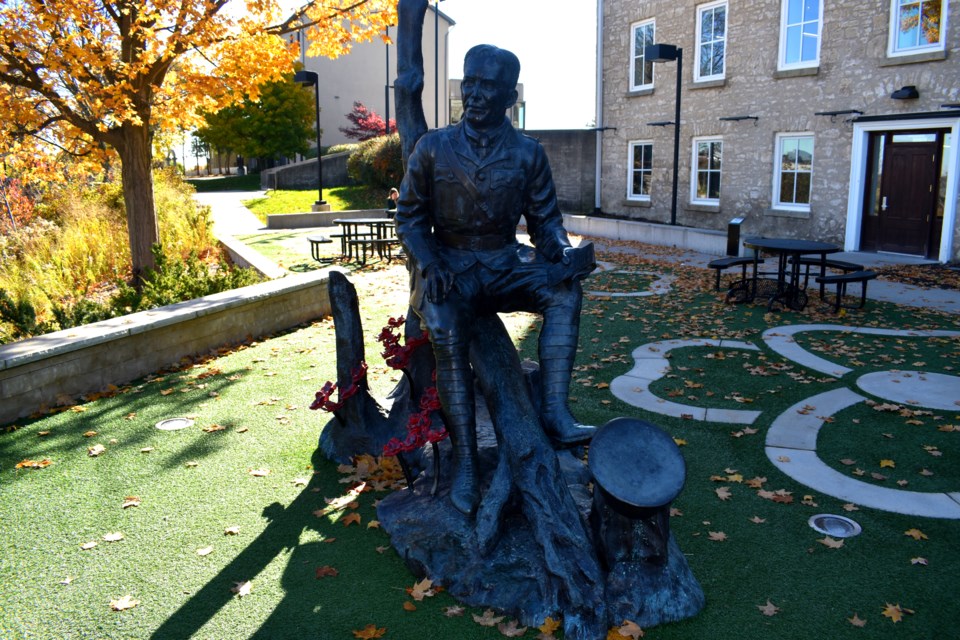While many Canadians are aware of the symbolism of the Canadian poppy, and why they bloom on the lapels of Canadians every November, the history of the poppy being adopted spans over a century and ties back to Guelph.
This year marks the 100th anniversary of the poppy being worn as a symbol of remembrance in Canada after the launch of the poppy campaign in 1921, with the origin of the symbolic visual pledge to honour Canada’s Veterans traced back to Guelph-born LTC John McCrae.
The Association of Canada, the Legion's predecessor, officially adopted the poppy as a symbol of remembrance on July 6, 1921, and since then has expanded both across Canada and internationally as a symbol of remembrance in Canada and the Commonwealth.
A Canadian medical officer during the First World War, McCrae is the author of the poem In Flanders Fields, which according to The Royal Canadian Legion inspired Anna Guérin, a woman from France, with the idea for the Remembrance Poppy.
“John McCrae, at least in the First World War, was a gifted physician in Montreal, a published poet and a well-known poet,” said Tim Cook, the Canadian War Museum's director of research.
McCrae was known to keep a diary and a series of letters that expressed his inner thoughts, including the dread he felt that he might be killed along with many of his comrades.
“I think as he was operating on these bleeding and dying soldiers and saving many of them while losing some of them, he composed poetry in his head to keep his mind off it. I think like a cathartic release," said Cook.
“John McCrae went overseas as a physician, and at the second battle of Ypres in April of 1915, that’s the battle where the Germans unleashed chlorine poisoned gas for the first time in the history of warfare, and McCrae was on that battlefield," said Cook.
McCrae was an accomplished poet who had been published numerous times in Canada.
“The poem that spilled out of him, which of course has become so iconic, he read it and threw it away because I think he had different versions of the poem in his head,” said Cook.
The poem was picked up and read by multiple readers who recognized the significance of the poem.
McCrae submitted it to a magazine, however, he was turned down
“Then he submitted it again in December 1915 to Punch Magazine, and Punch Magazine was probably the most famous magazine in the British Empire, and it was published,” said Cook.
“Interestingly, it was published anonymously, his name wasn’t attached to it, and it took several months for people to figure out it was him who had written it. He had written in a style like this before the war, so his close friends understood it was he who had written in.”
According to the Royal Canadian Legion, Guérin originally founded a charity to help rebuild regions of France torn apart by the First World War, and created poppies made of fabric to raise funds.
Guérin presented her concept to France’s allies, including the precursor to The Royal Canadian Legion, The Great War Veterans Association.
“I think that’s the interesting part of the poem, again, if you look at the words it is a military poem, it is a marshall poem,” said Cook. It is about his friends and comrades who have been killed on this battlefield and they are calling upon the living to keep up this fight.”
Cook said then when reading McCrae’s letters, it makes it very clear he believed in this war against Germany, he saw Germany as an aggressive nation as did many Canadians.
“The poem itself during the war was used in recruiting and used to sell victory bonds and was very much a part of that war effort,” said Cook. “But then after the war, as Canada was burying its young men and women with more than 66,000 dead, we as Canadians went through trying to make meaning out of the war.”
McCrae passed away on Jan. 28, 1918, after a severe battle with pneumonia.



